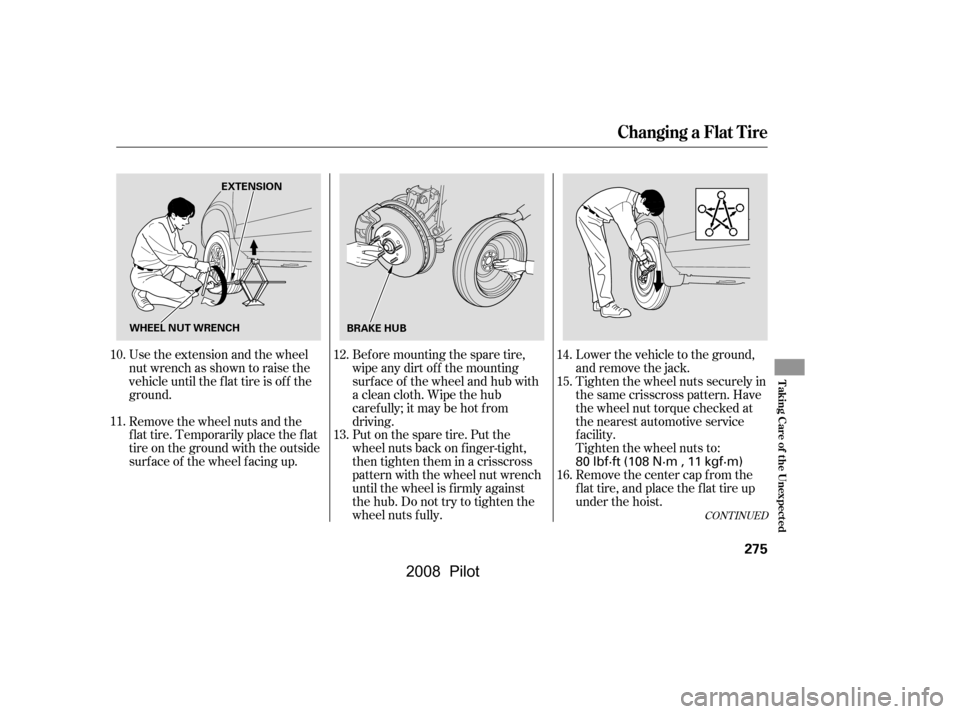Page 279 of 329

Use the extension and the wheel
nut wrench as shown to raise the
vehicle until the f lat tire is of f the
ground.Bef ore mounting the spare tire,
wipeanydirtoff themounting
surface of the wheel and hub with
a clean cloth. Wipe the hub
carefully;itmaybehotfrom
driving.
Put on the spare tire. Put the
wheel nuts back on f inger-tight,
then tighten them in a crisscross
pattern with the wheel nut wrench
until the wheel is f irmly against
the hub. Do not try to tighten the
wheel nuts f ully.Tighten the wheel nuts securely in
the same crisscross pattern. Have
the wheel nut torque checked at
the nearest automotive service
f acility.
Tighten the wheel nuts to:
Remove the center cap from the
flat tire, and place the flat tire up
under the hoist.
Remove the wheel nuts and the
flat tire. Temporarily place the flat
tire on the ground with the outside
surf ace of the wheel f acing up. Lower the vehicle to the ground,
and remove the jack.
10.
11. 12.
13.14.
15.
16.
CONT INUED
Changing a Flat Tire
T aking Care of t he Unexpect ed
275
EXTENSION
BRAKE HUB
WHEEL NUT WRENCH
80 lbf·ft (108 N·m , 11 kgf·m)
�\f���—�\f���—�\f���y�
�
����\f������y���
�(���+�����\f�y�\f�����\f�y
2008 Pilot
Page 286 of 329

If necessary, add oil to bring the
level back to the full mark on the
dipstick (see page ).
Saf ely pull of f the road, and shut
of f the engine. Turn on the hazard
warning lights.
Let the vehicle sit f or a minute.
Open the hood, and check the oil
level (see page ). An engine
very low on oil can lose pressure
during cornering and other driving
maneuvers.
Start the engine and watch the oil
pressure indicator. If it does not go
out within 10 seconds, turn of f the
engine. There is a mechanical
problem that needs to be repaired
bef ore you can continue driving
(see on page).
This indicator should never
come on when the engine is
running. If it starts f lashing or stays
on, the oil pressure has dropped very
low or lost pressure. Serious engine
damage is possible, and you should
take immediate action. If the charging system
indicator comes on brightly
when the engine is running, the
battery is not being charged.
Immediately turn of f all electrical
accessories. Try not to use other
electrically operated controls such as
the power windows. Keep the engine
running; starting the engine will
discharge the battery rapidly.
Go to a service station or garage
where you can get technical
assistance.
1.
2.
3.
4.
191
245
285
L ow Oil Pressure Indicator Charging System Indicator
Emergency T owing
L ow Oil Pressure Indicator, Charging System Indicator
282
Running the engine with low oil
pressure can cause serious mechanical
damage almost immediately. Turn of f
the engine as soon as you can saf ely get
the vehicle stopped.
�\f���—�\f���—�\f���y�
�
����
������y���
�(���+�����\f�y�\f�������y
2008 Pilot
Page 288 of 329

If you must drive the vehicle a short
distance in this condition, drive
slowly and caref ully.
However, if the brake pedal does not
f eel normal, you should take
immediate action. A problem in one
part of the system’s dual circuit
design will still give you braking at
two wheels. You will f eel the brake
pedal go down much f arther bef ore
the vehicle begins to slow down, and
you will have to press harder on the
pedal.
If the brake system indicator comes
on while driving, the brake f luid level
is probably low. Press lightly on the
brake pedal to see if it f eels normal.
If it does, check the brake f luid level
thenexttimeyoustopataservice
station (see page ). The brake system
indicator normally
comes on when
you turn the ignition switch to the
ON (II) position and as a reminder to
check the parking brake. It will stay
on if you do not f ully release the
parking brake.
If the f luid level is low, take your
vehicle to a dealer, and have the
brake system inspected f or leaks or
worn brake pads. Slow down by shif ting to a lower
gear, and pull to the side of the road
when it is saf e. Because of the long
distance needed to stop, it is
hazardous to drive the vehicle. You
should have it towed, and repaired as
soon as possible (see
on page ). If the ABS indicator and the VSA
system indicator come on with the
brake system indicator, have your
vehicle inspected by your dealer
immediately.
285
252
Brake System Indicator
Emergency
Towing
284
U.S. Canada
�\f���—�\f���—�\f���y�
�
����
������y���
�(���+�����\f�y�\f�������y
2008 Pilot
Page 289 of 329
If your vehicle needs to be towed,
call a prof essional towing service or
organization. Never tow your vehicle
with just a rope or chain. It is very
dangerous.
Any other method of towing will
damage the drive system. When you
contact the towing agency, inf orm
them a f lat-bed is required.The operator will load
your vehicle on the back of a truck.
The vehicle’s f uses are located in
f our f use boxes. The interior f use
boxes are located under the
dashboard on the driver’s and
passenger’s side.
On 4WD models
CONT INUED
Emergency T owing
The only way you can saf ely tow
your vehicle is with f lat-bed
equipment.Fuses
Emergency Towing, Fuses
T aking Care of t he Unexpect ed
285
DRIVER’ S SIDE INTERIOR
Towing with only two tires on the
ground will damage parts of the 4WD
system. It should be transported on a
f lat-bed truck or trailer.
�\f���—�\f���—�\f���y�
�
����
������y���
�(���+�����\f�y�\f�����\f�y
2008 Pilot
Page 300 of 329

Quality grades can be f ound where
applicable on the tire sidewall
between tread shoulder and
maximum section width. For
example:The treadwear grade is a compara-
tive rating based on the wear rate of
the tire when tested under controlled
conditions on a specif ied government
test course. For example, a tire
graded 150 would wear one and one-
half (1 1/2) times as well on the
government course as a tire graded
100. The relative perf ormance of
tires depends upon the actual condi-
tions of their use, however, and may
depart signif icantly f rom the norm
due to variations in driving habits,
service practices and dif f erences in
road characteristics and climate.The traction grades, f rom highest to
lowest, are AA, A, B, and C. Those
grades represent the tire’s ability to
stop on wet pavement as measured
under controlled conditions on
specif ied government test surf aces
of asphalt and concrete. A tire
marked C may have poor traction
perf ormance.
Warning: The traction grade
assignedtothistireisbasedon
straight-ahead braking traction tests,
and does not include acceleration,
cornering, hydroplaning, or peak
traction characteristics.
The tires on your vehicle meet all
U.S. Federal Saf ety Requirements.
All tires are also graded f or
treadwear, traction, and temperature
perf ormance according to
Department of Transportation
(DOT) standards. The f ollowing
explains these gradings.
All passenger car tires must conf orm
to Federal Saf ety Requirements in
addition to these grades.
DOT Tire Quality Grading (U.S. Vehicles)
Unif orm T ire Quality Grading
T readwear 200
Traction AA
Temperature A T readwear T raction
296
�\f���—�\f���—�\f���y�
�
���������\f�y���
�(���+�����\f�y�\f���\f�
�y
2008 Pilot
Page 311 of 329
Customer Service................................
Inf ormation .308
....................
Warranty Coverages .309
Reporting Saf ety Def ects
..........................
(U.S. Vehicles) .310
.....................
Authorized Manuals .311
Warranty and Customer Relations
Warrant y and Cust omer Relat ions
307
�\f���—�\f���—�\f���y�
�
�������
�\f�y���
�(���+�����\f�y�\f���
���y
2008 Pilot
Page 312 of 329

Honda dealership personnel are
trained prof essionals. They should
be able to answer all your questions.
If you encounter a problem that your
dealership does not solve to your
satisf action, please discuss it with
the dealership’s management. The
service manager or general manager
can help. Almost all problems are
solved in this way.
If you are dissatisf ied with the
decision made by the dealership’s
management, contact your Honda
Customer Service Office.
U.S. Owners:Canadian Owners: When you call or write, please give
us this inf ormation:
Vehicle Identif ication Number
(see page )
Name and address of the dealer
who services your vehicle
Date of purchase
Mileage on your vehicle
Your name, address, and tele-
phone number
A detailed description of the
problem
Name of the dealer who sold the
vehicle to you
In Puerto Rico and the U.S. Virgin
Islands: 292
Customer Service Inf ormation
308
American Honda Motor Co.
Honda Customer Service
Mail Stop 500-2N-7D
1919 Torrance Boulevard
Torrance, California 90501-2746
Tel: (800) 999-1009Honda Canada Inc.
715 Milner Avenue
Toronto, ON
M1B 2K8
Tel: 1-888-9-HONDA-9
Fax: Toll-free 1-877-939-0909
Toronto (416) 287-4776
Bella InternationalP.O. Box 190816
San Juan, PR 00919-0816
Tel: (787) 620-7546
Customer Relations
�\f���—�\f���—�
�\f�y�
������\f������y���
�(���+�����\f�y�\f���
���y
2008 Pilot
Page 315 of 329

T he publications shown below can be purchased f rom Helm
Incorporated. You can order by phone or online:Call Helm Inc. at 1-800-782-4356 (credit card orders only)
Go online at
If you are interested in other years or models, contact Helm Inc.
at 1-800-782-4356.
Covers maintenance and recommended procedures f or
repair to engine and chassis components. It is written
f or the journeyman mechanic, but it is simple enough
f or most mechanically inclined owners to understand.
Complements the Service Manual by providing in-depth
troubleshooting inf ormation f or each electrical circuit
in your vehicle.
Describes the procedures involved in the replacement
of damaged body parts.
Purchasing Factory Authorized Manuals
Electrical T roubleshooting Manual:
Service Manual:
Body Repair Manual:
(U.S.only)
Authorized Manuals
Authorized Manuals
311
Publication
Form Number 61S9V05
61S9V05EL
61S9V30
31S9V650
31S9V810
31S9VM30 31S9VQ50 HON-R Form Description
2006-2008 Honda Pilot Service Manual 2008 Honda Pilot
Electrical Troubleshooting Manual 2003 Model Series Honda Pilot Body Repair Manual
2008 Honda Pilot Owner’s Manual 2008 Honda Pilot
Navigation System Owner’s Manual
2008 Honda Pilot Honda Service History 2008 Honda Pilot Quick Start GuideOrder Form for Previous Years-
Indicate Year and Model Desired
www. helminc. com
�\f���—�\f���—�\f���y�
�
���������\f�y���
�(���+�����\f�y�\f���
���y
2008 Pilot